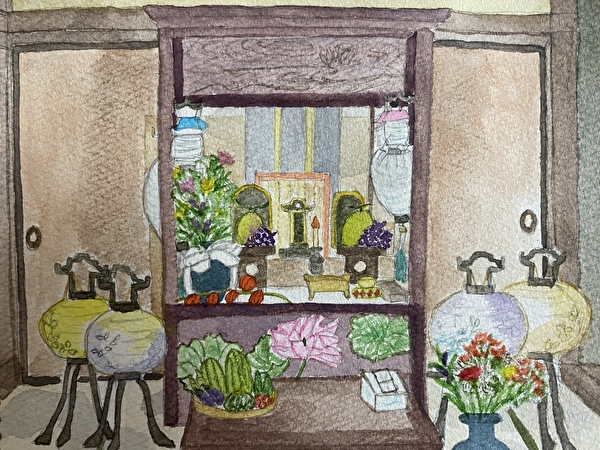During the Obon festival, we make an altar called a “Bon-dana” to welcome the spirits of our ancestors. We enshrine Ihai (ancestral tablets) in the center of the shelf. We offer a light offered to a god or Buddha, incense sticks, fresh flowers, dumplings, somen noodles, and seasonal vegetables and fruits on the shelf. We decorate with lanterns, which are called Bon Chochin, and rotating Chochins with designs, on either side of the shelf. This painting is an example of one such “Bon-dana”. Obon events and customs depend on the region they live in and the religious sect they follow.
The Obon festival is formally known as the Urabon-e festival. Urabon is a phonetic transcription of the Sanskrit word “uravanna,” which means suffering as if hung upside down (the suffering of hell). And it represents a legend about Mokuren, one of Buddha’s disciples. The legend is that when Mokuren learns that his dead mother is being hanged upside down in hell, he asks Buddha how to save her. It is said that the current custom of Obon started because Buddha’s teaching was to make offerings on the 15th day of the 7th month (lunar calendar).
Nowadays, the middle day of the Obon Festival is August 15th according to the new calendar, and the four days from August 13th to 16th are used as the Obon Festival in many places. Obon vacations for stores and companies often refer to about three to four days of this period. And they can be as long as a week vacation, including weekends. We have a custom of welcoming and spending time with the spirits of our ancestors during Obon, just as we do at New Year’s.
In general, the welcoming fire is lit on the 13th, the beginning of the Obon Festival, to welcome the ancestors, and the sending fire is lit on the 16th, the end of the Obon Festival, to send them back to the other world. People make and decorate a Bon-dana and on the 14th and 15th, they often make three offerings of the same meal as the family on it. These are called “Butsuzen,” and are served in a special set of bowls and plates. It is also said that sharing the offerings of Obon with your ancestors is a way to make offerings to them. And it is also important to clean the graves and Buddhist altars in advance of Obon.
Cucumber horses and eggplant cows with toothpicks and split chopsticks as legs are famous as Obon decorations. They are called “Shoryo-uma” (Spirit horse) to wish for the quick return of the ancestors, and “Shoryo-ushi” (Spirit cow) to wish for a slow return to the other world. Both are made to use them to resemble vehicles for our ancestors to travel between this world and the other.
Bon Chochins, like welcoming and sending fires, are prepared to be a landmark for the ancestors to return to their hometowns without getting lost. There are Chochins (hanging paper lanterns) that are hung from the top and Anndons (Japanese-style lampstands) that are placed on the floor. Because the color and shape of the hozuki (ground cherry) remind people of Chochin (lanterns), a hozuki is displayed as lanterns for the spirits.
Obon events held in various parts of Japan today are customs that have been handed down from generation to generation by a fusion of ancient agricultural rituals, Sorei Shinko (the worship of ancestors), and Buddha. For example, there are sending bonfires, welcoming bonfires, Bon dances, Shoryo Nagashi (floating lanterns carrying the spirits of the dead), fireworks displays, summer festivals, and so on. And there are many differences between them depending on the region and sect. In this sense, there is no rule that says this is the absolutely correct way to welcome Obon. In ordinary households, families and relatives gather to welcome the spirits of their ancestors and make offerings to thank them for making them who they are today.
お盆には「盆棚」と呼ばれる祭壇を作り、ご先祖様の精霊をお迎えします。棚の中央に位牌を安置します。灯明(神仏に捧げる灯り)、線香、生花、だんご、そうめん、季節の野菜や果物などを並べてお供えします。棚の左右には盆提灯と呼ばれる提灯や、絵柄の入った回転提灯を飾ります。この絵はそんな盆棚の一つの例です。お盆の行事や風習は住む地域や信仰する宗派によって変わってきます。
お盆は正式には「盂蘭盆会(うらぼんえ)」といいます。盂蘭盆とは、サンスクリット語で逆さに吊るされたような苦しみ(地獄の苦しみ)を意味する「ウラバンナ」を音写したものです。そして、お釈迦様の弟子の一人、目連(もくれん)にまつわる言い伝えを表しています。その言い伝えとは、亡き母が地獄で逆さ吊りの刑を受けていることを知った目連が、母親を救済する方法をお釈迦様から聞くというものです。お釈迦様の教えが「(旧暦)7月15日に供養する」というものだったことから、現在のお盆の風習が始まったとされています。
現在では新暦で8月15日を中日とし、8月13日から16日にかけての4日間をお盆とするところが多いです。お店や会社のお盆休みはこの期間の3~4日程度を指すことが多く、土日などを含めて1週間程度の大型連休になることもあります。お盆にはお正月と同じように家族が集まって精霊をお迎えし、一緒に過ごす習慣があります。
一般的には、盆の入りである13日に迎え火を焚いてご先祖様をお迎えし、盆明けの16日に送り火を焚いてあの世へ再びお送りします。盆棚を飾り、14、15日には、家族と同じ食事を3度お供えすることが多いようです。これを「仏膳」と呼び、専用のお椀とお皿などのセットに盛られます。そしてお盆のお供え物はご先祖さまと分け合っていただくことで供養になると言われています。また、お盆を迎えるに当たり、お墓や仏壇の掃除を事前に済ませておくことも大事です。
お盆飾りとして、爪楊枝や割りばしを足にしたキュウリの馬とナスの牛が有名です。ご先祖様に早く帰ってきて欲しい願いを込めて精霊馬(しょうりょううま)、ゆっくりあの世に帰って欲しい願いを込めて精霊牛(しょうりょううし)、と呼ばれています。どちらもご先祖様がこの世とあの世を行き来するのに使う乗り物に見立てて作られています。
盆提灯は、迎え火や送り火と同じように、ご先祖様が迷うことなく里帰りするための目印として用意されます。上から吊るして飾る提灯や、床置きして飾る行灯(あんどん)などがあります。また、ほおずきの色や形が提灯を連想させることから、精霊の為の提灯としてほおずきも飾られます。
現在、日本各地で行われているお盆の行事は、古代の農耕儀礼と祖霊信仰と仏教が融合して代々受け継がれてきた風習です。例えば、送り火、迎え火、盆踊り、精霊流し、花火大会、夏祭りなどがあります。それらには地域や宗派によってさまざま違いがあります。その意味で、これが絶対正しいお盆の迎え方、という決まりはありません。一般の家庭では、家族や親戚が集まり先祖の霊を迎え、今の自分があるのは先祖のおかげと感謝供養する行事として行われています。
Ikuyo.K.
RECENT POSTS

